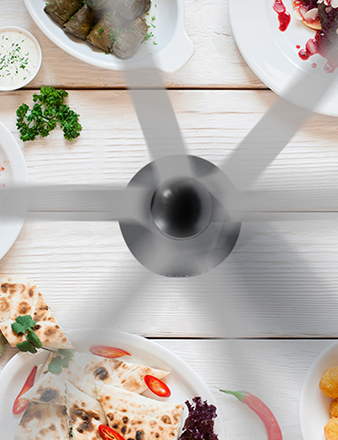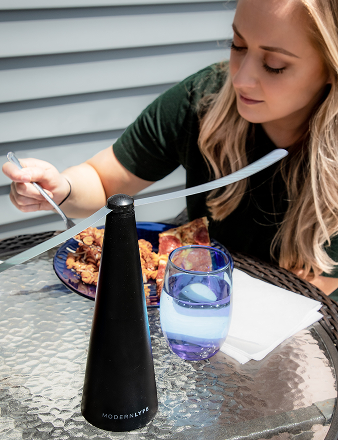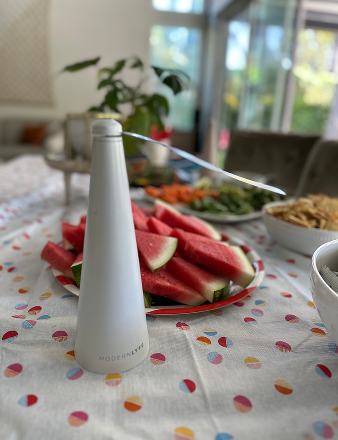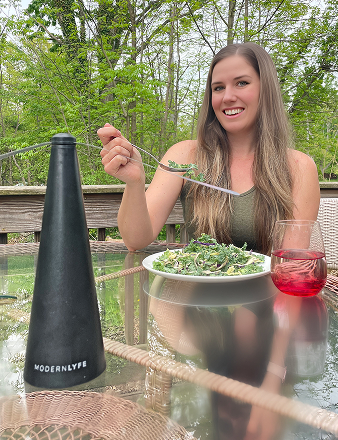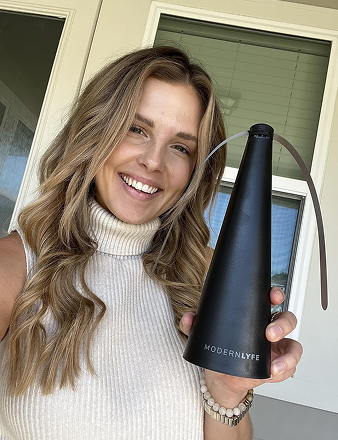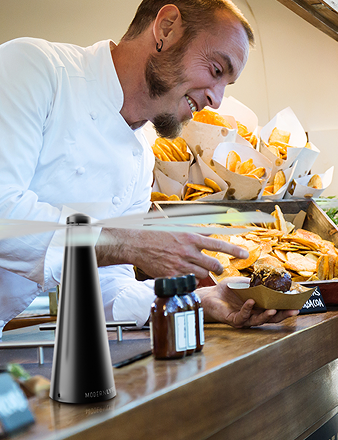Picture this: The grill is hot, the drinks are cold, and just as you sit down for that perfect backyard meal, they show up. Flies. Your relaxing dinner instantly becomes a battle of swatting and shooing.
It’s a common frustration, but it doesn't have to be your reality. You can win the fight against flies. The secret isn't one magic trick; it's about being smarter than they are.
The key is to think like a fly. Flies are driven by two simple things: enticing smells and a safe place to land. If you systematically remove those two things, you create an environment where they have no reason to be. It’s all about building a defense in layers.
Your 3-Part Plan for a Fly-Free Zone
A successful defense combines several tactics that work together. Some are prep work, while others are active measures you take during the meal. It all comes down to these three pillars:
-
Master Your Environment: This is your foundation. It means getting your outdoor space genuinely clean—no sticky soda spills, no leftover crumbs, and no hidden gunk on the grill that signals "dinner is served" to every fly in the neighborhood.
-
Set Up for Success: This is about how you arrange your dining area. Simple things, like where you place the food table and using physical barriers like mesh food covers, can make a huge difference. It's about turning your food into a fortress.
-
Deploy Active Defenses: These are the tools you use in real time. We’re talking about things like the MODERN LYFE fly fan, which creates an invisible, fly-proof barrier right where you need it most.
The most powerful takeaway is this: it's far easier to prevent flies from showing up than it is to evict them once they've crashed your party. For a deeper dive, check out our complete guide on how to keep flies away from food.
With that in mind, let’s get straight to the practical, actionable steps that actually work. We'll break down each layer of this defense system so you can finally reclaim your peaceful outdoor meals.
Fly Defense At a Glance
Here’s a quick overview of the most effective methods to keep your outdoor dining experience fly-free. Think of it as your cheat sheet for a peaceful meal.
| Strategy Type | Key Action | Why It Works |
|---|---|---|
| Environmental Control | Deep clean the patio, grill, and trash areas | Removes the food odors and residue that attract flies from a distance. |
| Physical Barriers | Use mesh food tents or cloches | Creates a physical shield that prevents flies from landing on your dishes. |
| Airflow Disruption | Place MODERN LYFE fly fans near food | The spinning blades create an air current that flies find impossible to navigate. |
By layering these simple but effective tactics, you're not just hoping for a fly-free meal—you're actively creating one.
Create a No-Fly Zone Before Guests Arrive
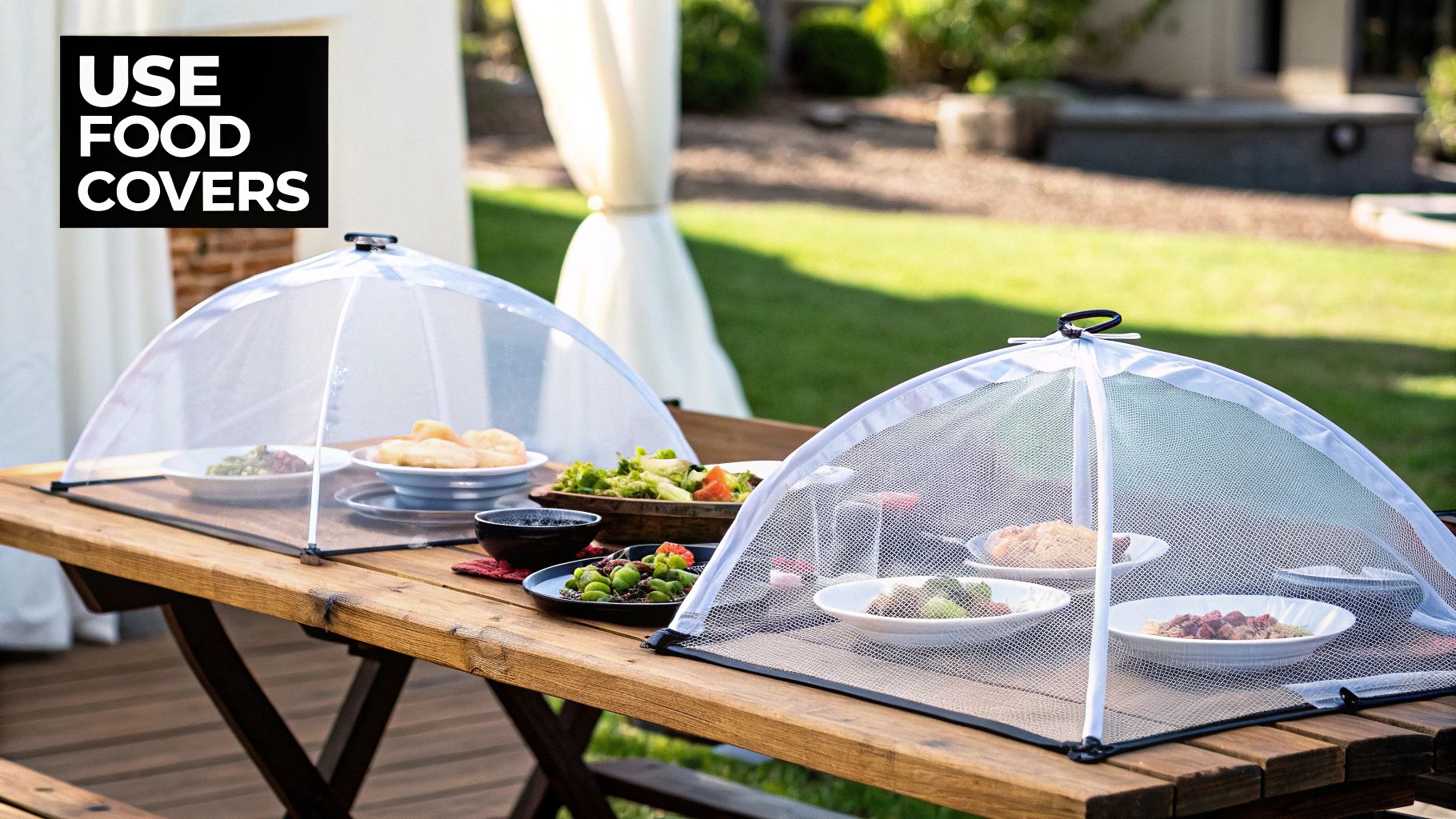
To keep flies away from your food, the best defense is a good offense. This means making your space completely unappealing to them long before the first burger hits the grill. A truly fly-free gathering starts with prep work a day or two in advance.
Flies are relentlessly drawn to odors and leftover food residue. Scents you can't even detect are like a giant neon sign for them. Your first mission is a deep, strategic clean of your entire outdoor entertaining space. Think like a fly: where would you find a snack?
Sanitize Your Core Entertaining Area
This isn't just a quick sweep. It’s about eliminating the microscopic food particles that act as a powerful fly magnet.
A pressure washer is your best tool for this job, blasting away unseen grime from your patio, deck, and walkways. No pressure washer? A stiff-bristled brush, hot soapy water, and some effort will do the trick. Pay close attention to the gaps between deck boards or cracks in the concrete—that's where spills and crumbs hide.
Tackle the Grill and Trash Cans
Let's be honest: the grill is a major offender. Caked-on grease and charred food bits are a five-star restaurant for flies. A thorough grill cleaning is non-negotiable. Scrape the grates, empty the grease trap, and wipe down the entire exterior.
Just as important are your trash and recycling bins. Even when empty, the residue inside can create a powerful stink that flies find irresistible.
- Move Your Bins: The easiest win is to relocate all trash cans at least 15-20 feet away from where you'll be cooking and eating.
- Scrub Them Clean: Before your event, hose down and scrub the inside of your bins with a strong cleaner to eliminate sticky, smelly gunk.
- Always Use Liners & Lids: Make sure every bin has a fresh liner and a lid that fits snugly to contain odors.
Taking a few minutes to manage your waste bins can dramatically reduce the number of flies that even notice a party is happening.
A tiny amount of waste creates a huge fly problem. Research on fly control for food safety shows that filthy organic debris is a prime breeding ground. A staggering 800 fly maggots can thrive in just one ounce of waste. It’s a stark reminder that a bit of overlooked grime can fuel a massive fly invasion.
Your Pre-Event Checklist
Right before setting up, do one last walkthrough. This isn’t just about cleaning; it’s about ensuring you’ve built a defensive perimeter that flies won’t want to cross.
The No-Fly Zone Checklist:
- Patio and Deck: Are all surfaces scrubbed clean? Run your hand over the tabletop—no sticky spots allowed.
- Grill Area: Is the grill clean inside and out? Is the grease trap completely empty?
- Trash Cans: Are the bins clean, lined, lidded, and moved a good distance away?
- Standing Water: Have you dumped any stagnant water from planters, toys, or birdbaths?
- Pet Waste: Is the yard 100% clear of pet droppings?
When you proactively address these attractants, you’re not just cleaning up. You’re setting the stage for success. This foundational work makes every other fly deterrent—from food covers to fly fans—vastly more effective.
Set Up a Smarter Food Station

Once your yard is prepped, your next line of defense is how you set up the food. A little strategy here turns your picnic table into a fortress flies can't breach. It's about thinking one step ahead of them.
First, location. Try to see your yard through a fly's eyes. Where do they hang out? Position your main food spread as far away from those spots as possible—garbage cans, compost heaps, or dense, shady bushes where they rest.
Placing just 15-20 feet between your buffet and these fly magnets can drastically cut down on unwanted guests. This simple move creates a buffer, making every other trick more effective.
Create an Invisible Air Barrier
Here’s a game-changing tip: use air movement to your advantage. Flies are terrible pilots. They’re tiny and light, so even a gentle, consistent breeze makes it incredibly difficult for them to fly straight, let alone land on your potato salad.
Grab an oscillating fan (or two for a larger spread) and set it to blow a current of air across the surface of your food table. The flies simply can't push through it. You've created an invisible wall, a no-fly zone protecting your most valuable real estate.
A common mistake is aiming fans at guests for cooling. While nice, the real mission here is protecting the food. Keep the fans low and aim them to sweep just over the top of the dishes. This creates the perfect protective shield without sending napkins flying.
Use Physical Shields for Full Protection
Airflow is your active, invisible defense, but physical covers are your non-negotiable backup. Never leave food completely exposed, not even for a minute. It takes seconds for a fly to find an open dish.
Luckily, there are plenty of effective and stylish options.
- Mesh Food Tents: A classic for a reason. Modern versions are often weighted or have skirts at the bottom so they don't blow away. They protect food while letting everyone see what's available.
- Plate Covers and Domes: For specific platters or bowls, a cloche or a roll-top chafing dish is perfect. They keep things sealed tight until someone is ready to eat.
- Beverage Dispensers: Open pitchers of sweet tea or lemonade are a magnet for flies. Swap them out for sealed glass dispensers with a spigot. This simple change completely eliminates flies dive-bombing your drinks.
By combining smart placement, a barrier of air, and physical covers, you're building layers of defense. This proactive approach stops flies from ever becoming a problem, letting you and your guests enjoy the meal in peace.
Deploy Active Deterrents That Actually Work
You’ve prepped the area and covered the food. Now it’s time for the final, active layer of your fly defense—the tools you use during the meal to handle any persistent stragglers.
Forget old wives' tales and gimmicky DIY traps. We're focusing on what seasoned hosts know really works. The idea is to create an environment that's actively hostile to flies, disrupting their senses and creating a protective bubble.
Harness the Power of Modern Fly Fans
If there's one tool to swear by for keeping flies off an outdoor table, it's a specialized fly fan. These aren't average fans; they're designed with one purpose: repelling flies without chemicals or noise. The magic is in their soft, holographic blades.
As the blades spin, they scatter light, creating a constantly shifting, disorienting pattern. To a fly's sensitive compound eyes, this visual chaos is alarming. They see it as a threat and steer clear. It's an effective, silent, and safe way to guard your food. To see the top models, you can explore the best fly repellent fan options available.
The real beauty of a MODERN LYFE fly fan is its targeted protection. Place one or two directly on the table, right next to the food platters. This creates a powerful, localized defense exactly where you need it most, without chemicals, odors, or noise interrupting your meal.
Create a Fragrant Perimeter with Natural Repellents
Beyond visual tricks, you can also use scents to your advantage. Many herbs contain potent essential oils that flies can't stand. Strategically placing these plants creates a natural, fragrant barrier around your dining and seating areas.
Some go-to options include:
- Mint: Flies hate the smell of mint. A few small pots of peppermint or spearmint on the dining table can be a functional, attractive centerpiece.
- Basil: This culinary herb is also a surprisingly powerful fly repellent. Its strong aroma helps keep them at a distance.
- Lavender: While we find the scent of lavender calming, flies find it repulsive. A few bundles of dried lavender or potted plants near the table work wonders.
- Rosemary: This hardy herb is another excellent choice. For extra punch, toss a few sprigs onto hot grill coals (away from the food) to release a plume of fly-repelling smoke.
This visual highlights just how crucial a clean environment is as the foundation of your entire strategy.
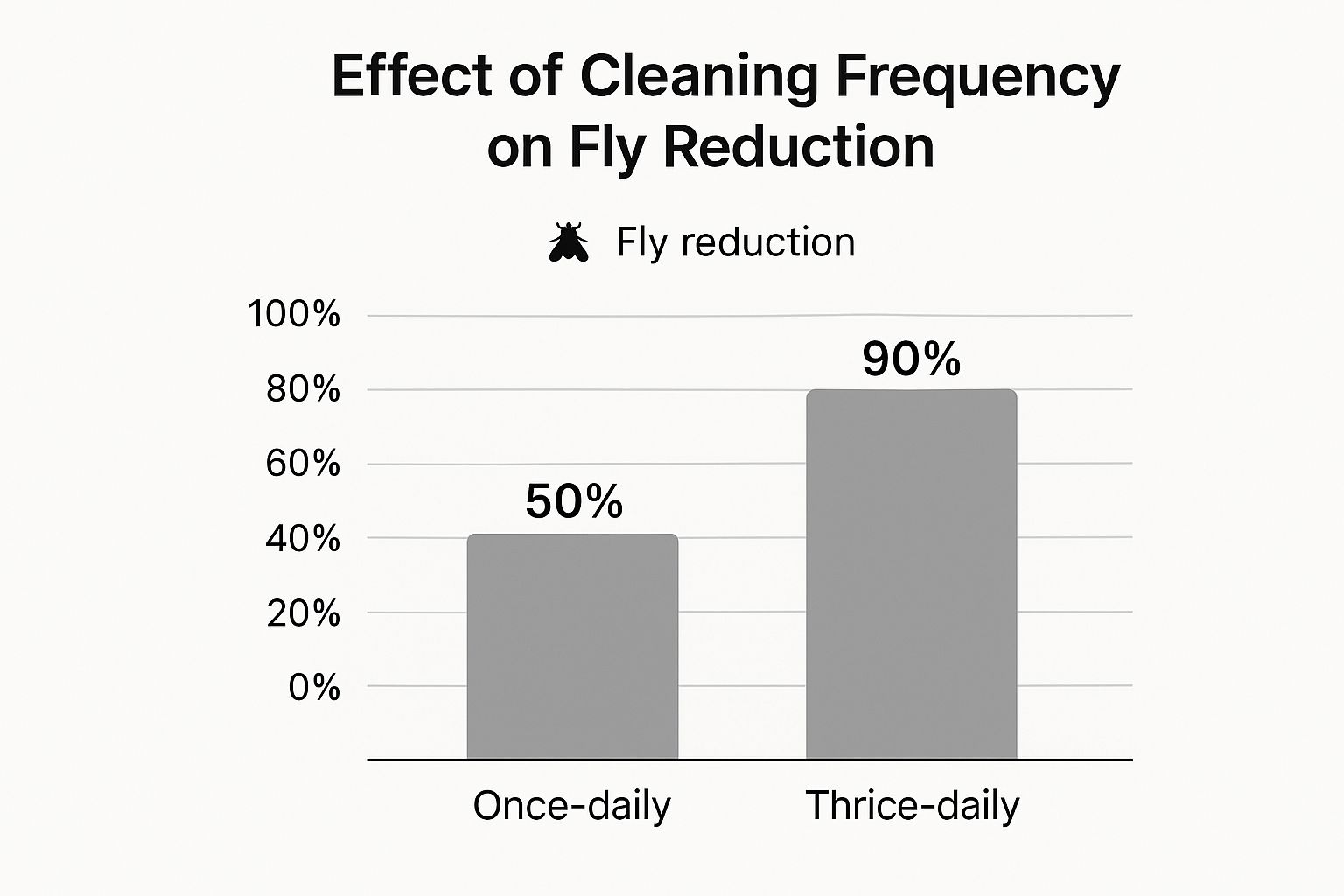
As you can see, simply clearing away food residue and spills more frequently drastically reduces the number of flies you'll have to deal with in the first place.
Comparing Fly Deterrent Methods
With so many options, it helps to see how they stack up. Here’s a quick comparison of popular fly deterrents to help you choose the best combination for your outdoor space.
| Method | Effectiveness | Best Use Case | Safety/Considerations |
|---|---|---|---|
| Fly Fans | High | Directly on or near the food table for targeted protection. | Very safe, chemical-free, quiet. Blade stops on contact. |
| Natural Herbs (Mint, Basil) | Moderate | As a perimeter defense around seating and dining areas. | Completely safe. Doubles as decor and cooking ingredients. |
| Citronella Candles | Low-Moderate | General area repellent, less effective for food protection. | Open flame hazard. Strong scent can interfere with food aroma. |
| Fly Traps (Bags/Jars) | High (for trapping) | Placed far away from your dining area to lure flies away. | Can be smelly and unsightly. Attracts flies before trapping them. |
| Zappers | Moderate | Perimeter of the yard, away from people and food. | Noise can be disruptive. Kills beneficial insects too. |
Ultimately, a multi-pronged approach gives you the best defense against these unwelcome guests.
Layer Your Defenses for Maximum Impact
The secret to a fly-free gathering isn't finding one single magic bullet. It’s about layering multiple deterrents to create overlapping fields of protection.
Start by placing your fly fans in the center of the action—right on the table next to the food. This establishes your primary no-fly zone. Then, surround your seating area with fragrant potted herbs like mint and basil. The combination of visual disruption from the fans and scent repulsion from the plants makes your space thoroughly uninviting to flies.
When you pair these active strategies with a clean environment and covered food, you build a comprehensive defense system that lets you and your guests finally enjoy an outdoor meal in peace.
Understand Seasonal Fly Patterns
Ever notice how some months bring a relentless swarm of flies, while others are peaceful? It’s not your imagination. Fly populations run on a distinct seasonal clock, and learning their rhythm is one of the best ways to keep them away from your food.
Their activity isn’t random; it’s driven by predictable environmental triggers. As temperature and humidity climb, these pests kick into high gear, breeding and searching for food more aggressively. This is precisely why late spring and summer often feel like a constant battle.
Of course, it's not just the weather. The availability of food is a huge factor in fly population booms. Their entire life cycle is tied to what’s available for them to eat and where they can lay their eggs.
Follow the Harvest Calendar
One of the biggest magnets for flies is ripening local fruit. As fruit matures and falls from trees, it starts to ferment. That sweet, pungent smell is a dinner bell, signaling to every fly in the area that a feast—and a nursery—is ready.
This isn't just a casual observation. Research compiling data from 43 countries confirms that fly populations have intensely seasonal cycles. These cycles peak in perfect sync with the availability of host fruits like apricots, peaches, and citrus.
This connection gives you a critical advantage. If you know local mulberry trees drop their fruit in June or a neighbor’s apple tree will be overloaded by late August, you can see a fly surge coming. This lets you get ahead of the problem instead of just reacting to it.
By tracking local harvest seasons, you can predict high-risk periods for fly infestations. This allows you to deploy stronger defenses, like extra fly fans or more frequent cleanups, before your outdoor event—not after the flies have already crashed the party.
Adjusting Your Strategy by Season
An effective strategy isn't one-size-fits-all; it must adapt to the time of year. Your approach for a cool spring day should look different from your battle plan for a mid-July heatwave.
Here’s a breakdown of how to tailor your efforts:
- Early Spring: This is the time for prevention. Deep clean your patio, grill, and furniture to eliminate any organic debris from winter that could become an early breeding ground.
- Late Spring & Early Summer: As temperatures consistently stay above 70°F (21°C), it's time to ramp up. Start using active deterrents like MODERN LYFE fly fans during every meal and be extra diligent about clearing food scraps immediately.
- Peak Summer: Now you need an all-out defense. Combine proactive sanitation with active measures. Use your fans, keep food covered at all times, and add natural repellents like potted mint or basil around your seating area.
- Late Summer & Early Fall: Don't get complacent. This is prime harvest time. Keep a close eye on fallen fruit in your yard and stick with your cleaning and deterrent routines.
Understanding these natural cycles helps you stay one step ahead. For more in-depth strategies, check out our guide on how to keep flies away outside. By aligning your fly control with their predictable patterns, you can reclaim your outdoor meals.
Taking on a Stubborn Fly Problem Head-On
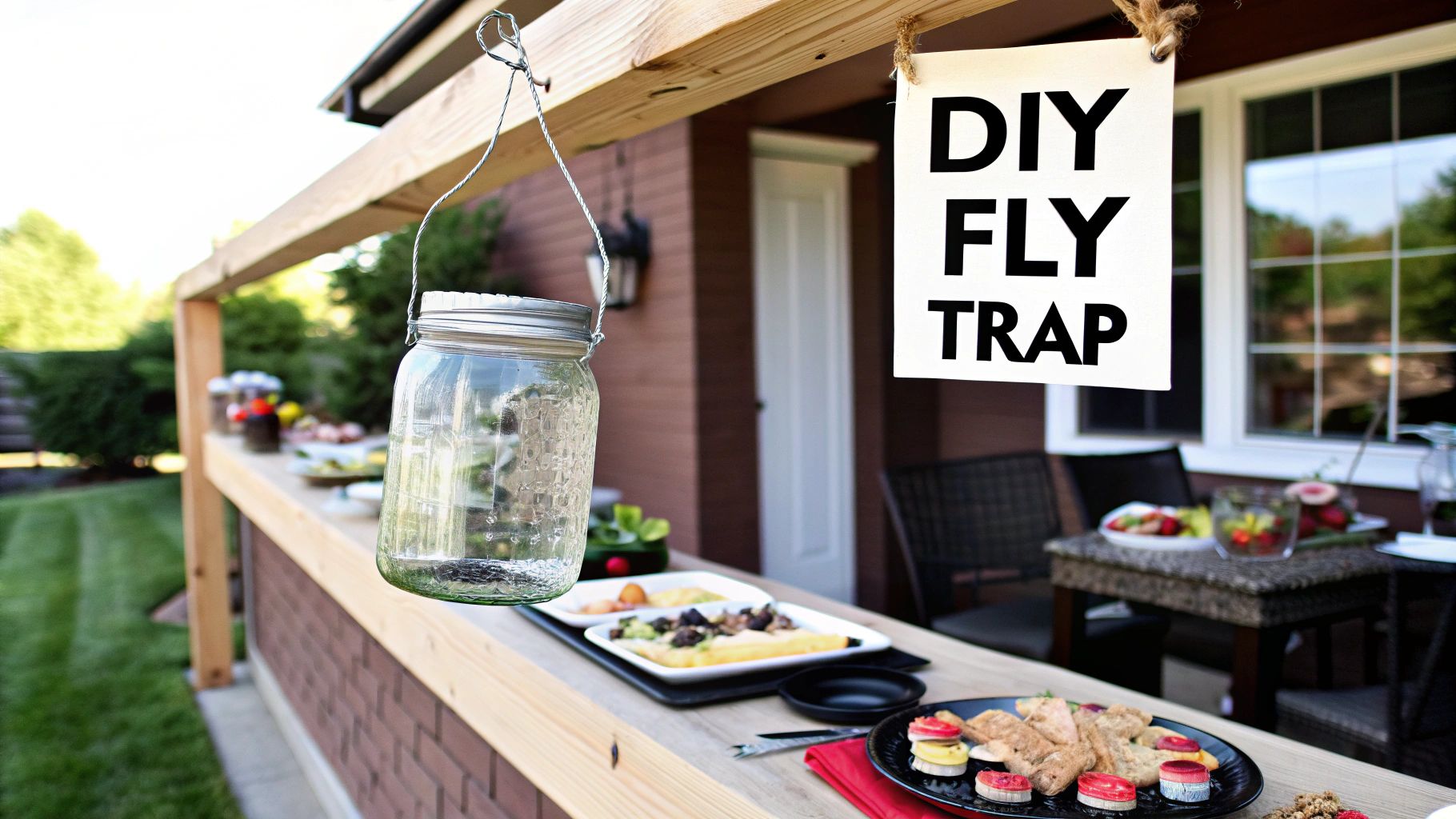
Sometimes, no matter how much you clean or how many fans you use, the flies just keep coming. When you’re facing a relentless swarm, it's time to stop playing defense and go on the offensive. This means borrowing a few pro tricks to figure out why you have so many flies and shut down the source for good.
You have to get past just swatting flies at your table and start understanding the real scope of the problem. Simple monitoring tools can give you the intel you need to take the right action.
First, Get an Accurate Headcount
To learn how to keep flies away from your food outdoors, you need to know what you're up against. Are we talking about a dozen visitors or a full-blown invasion? Professionals use simple tools to get actual numbers, and you can, too.
One of the easiest methods is using fly speck cards. It's as simple as it sounds. Place plain white index cards where you see flies landing and resting. Leave them out for a week, then count the black spots (fly droppings). This gives you a surprisingly clear picture of your fly population.
Monitoring isn't just for curiosity; it gives you clear, data-driven reasons to act. A count of 50 spots per card per week points to a moderate issue where you might need targeted baits. If you're seeing 100 spots or more, you’ve got a serious problem that calls for a more aggressive plan. You can read more about these surveillance and control strategies to see how the pros approach it.
Using speck cards moves you from reacting to thinking strategically. You're no longer guessing—you're making smart decisions based on real evidence.
Hunt Down and Destroy Their Breeding Grounds
Let’s be direct: a persistent fly problem almost always means there's a breeding site nearby. Flies don't commute for miles to crash your cookout; they are probably being born on your property or very close to it. Finding and eliminating that source is the only way to win for good.
Put on your detective hat and think like a fly. They need two things to start a family: moisture and decaying organic gunk. It's time to start searching.
Common Fly Breeding Hotspots to Check:
- Compost Bins: A compost pile that’s too wet or isn’t turned regularly is a fly nursery.
- Forgotten Trash: Did a garbage bag rip and leak? Look behind the shed or under the porch for any hidden trash or old yard waste.
- Soggy Spots: Check for corners of the yard with bad drainage where wet leaves, grass clippings, or other gunk gathers and stays damp.
- Pet Waste Zones: You’d be shocked how many flies can come from a small amount of overlooked pet poop. Clean these areas daily.
Once you find a likely spot, the fix is usually simple: clean it up, dry it out, and remove the organic material they're feeding on. For a compost pile, that might mean turning it more often and mixing in more "browns" like dried leaves. For a soggy corner, you may need to rake it clean and fix the drainage.
By combining an accurate count with a search-and-destroy mission for their breeding grounds, you get to the root of the problem. This is how you achieve lasting peace and finally enjoy your meals without the constant buzzing.
Still Have Questions? Let’s Talk Flies
Even with the best game plan, a few questions always pop up. Let’s cover some of the most common ones so you can fine-tune your approach and dine in peace.
What About DIY Fly Traps, Like Water Bags with Pennies?
The classic bag-of-water-with-pennies trick is one of those bits of folklore you see everywhere, but there's no real science to support it. The theory is that light refracting through the water disorients flies, but results are shaky at best.
It's harmless to try, but don't count on it as your main line of defense. You're much better off sticking with methods that are proven to work—keeping the area clean, using food covers, and setting up an active deterrent like a MODERN LYFE fly fan.
Which Foods Are the Biggest Fly Magnets?
Flies have an incredible sense of smell, and they play favorites. If you know what they're after, you'll know what needs the most protection.
- Anything Sweet: Spilled soda, fruit juices, and cut fruit like watermelon or melon. That leftover slice of cake is a five-star meal for a fly.
- Fermented Items: Anything with that slightly fermented aroma is a major draw. This includes open beer and wine bottles and even vinegar-based salad dressings.
- Meats and Proteins: From raw burgers waiting for the grill to a platter of cooked chicken or cold cuts, protein is irresistible to them.
The takeaway is simple: if it's sweet, smelly, or protein-rich, it needs a lid. Prioritize covering these dishes with mesh food tents or sealed containers.
Are Bug Zappers a Good Idea for Flies?
This is a big one. While bug zappers seem like an easy fix, I generally advise against using them anywhere near where you're eating. The bright UV light is a beacon for all kinds of insects, not just the flies you're targeting.
You end up killing beneficial bugs your garden needs. Even worse, the "zapping" action can create a fine mist of insect parts that can drift through the air and land on your table and your food. It's not sanitary. Safer, more targeted solutions like fly fans or natural repellents are a much smarter choice for mealtime.
Ready to enjoy your outdoor meals without the constant swatting? The MODERN LYFE fly fan creates a silent, chemical-free barrier that keeps flies away from your food for good. Explore the collection and reclaim your patio at modernlyfe.com.

